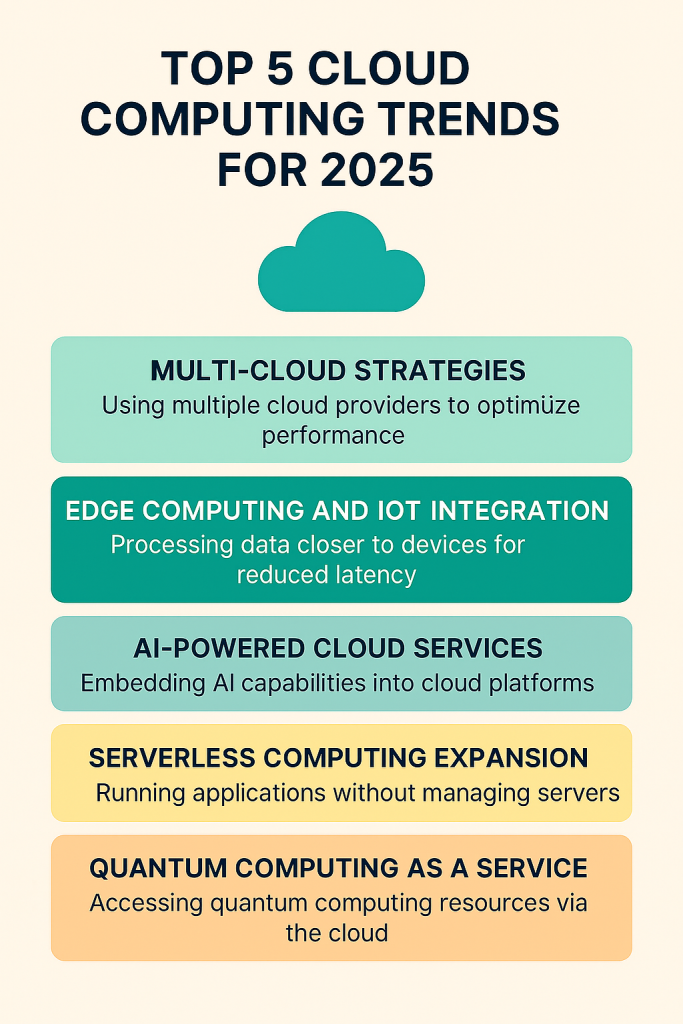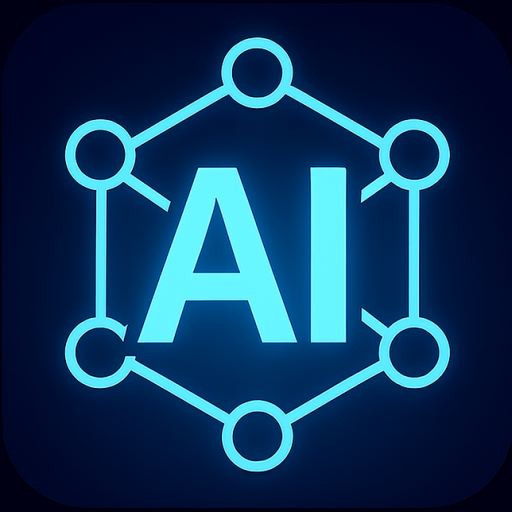Top 5 Cloud Computing Trends for 2025
Cloud computing has evolved from a cost-saving infrastructure solution into a strategic enabler of innovation, agility, and competitive advantage. In 2025, the cloud landscape is being shaped by a convergence of advanced technologies, new business demands, and heightened security and compliance requirements.

This article explores the five most significant cloud computing trends for 2025, their technical underpinnings, and their implications for enterprises.
1. Rise of Multi-Cloud Strategies
What it is:
A multi-cloud strategy involves using services from multiple cloud providers to optimize performance, cost, and resilience. Instead of relying on a single vendor, organizations distribute workloads across different platforms such as AWS, Microsoft Azure, Google Cloud, and specialized providers.
Why it matters in 2025:
- Avoiding vendor lock-in: By diversifying providers, businesses reduce dependency on a single vendor’s pricing, features, or service availability.
- Optimizing workloads: Different providers excel in different areas. For example, one may offer superior AI/ML capabilities, while another provides industry-leading analytics.
- Resilience and redundancy: Workloads can be shifted between providers during outages or performance degradation, improving uptime and business continuity.
Engineering considerations:
- Implementing cross-cloud networking and interoperability standards to ensure seamless workload migration.
- Using cloud management platforms to monitor costs, performance, and compliance across providers.
- Designing data governance policies that work across jurisdictions and platforms.
2. Edge Computing and IoT Integration
What it is:
Edge computing processes data closer to its source rather than sending it to centralized cloud servers. This is particularly important for Internet of Things (IoT) devices that generate large volumes of real-time data.
Why it matters in 2025:
- Reduced latency: Processing data locally improves response times for applications like autonomous vehicles, industrial automation, and smart cities.
- Bandwidth efficiency: Only relevant or aggregated data is sent to the cloud, reducing network congestion.
- Enhanced privacy: Sensitive data can be processed locally, reducing exposure risks.
Engineering considerations:
- Deploying micro data centers or edge nodes near data sources.
- Integrating edge AI models for real-time decision-making without cloud round trips.
- Ensuring synchronization between edge and cloud environments for analytics and storage.
3. AI-Powered Cloud Services
What it is:
Cloud platforms are embedding AI and machine learning capabilities directly into their infrastructure, enabling automation, predictive analytics, and intelligent application development.
Why it matters in 2025:
- Operational efficiency: AI automates resource allocation, scaling, and fault detection.
- Enhanced developer productivity: Pre-trained AI models and APIs accelerate application development.
- Security improvements: AI-driven monitoring detects anomalies and threats in real time.
Engineering considerations:
- Leveraging AI-optimized compute instances for training and inference.
- Integrating MLOps pipelines for continuous model deployment and monitoring.
- Addressing AI governance to ensure transparency, fairness, and compliance.
4. Serverless Computing Expansion
What it is:
Serverless computing allows developers to run code without managing servers. The cloud provider automatically handles infrastructure provisioning, scaling, and maintenance.
Why it matters in 2025:
- Cost efficiency: Pay only for the compute time used, with no idle resource costs.
- Scalability: Applications scale automatically based on demand.
- Faster time-to-market: Developers focus on writing business logic instead of managing infrastructure.
Engineering considerations:
- Designing event-driven architectures that trigger serverless functions.
- Managing cold start latency for performance-sensitive applications.
- Implementing observability tools to monitor distributed serverless workloads.
5. Quantum Computing as a Service (QCaaS)
What it is:
Quantum computing uses qubits to perform calculations that are infeasible for classical computers. QCaaS makes quantum capabilities accessible via cloud platforms.
Why it matters in 2025:
- Breakthrough performance: Quantum algorithms can solve optimization, simulation, and cryptography problems exponentially faster.
- Industry impact: Sectors like pharmaceuticals, finance, and climate modeling benefit from accelerated computation.
- Democratization: Cloud delivery removes the need for specialized on-premises quantum hardware.
Engineering considerations:
- Identifying quantum-suitable problems within business workflows.
- Using hybrid quantum-classical algorithms for near-term applications.
- Preparing for post-quantum cryptography to secure data against future quantum threats.
Conclusion
The cloud in 2025 is not just a hosting environment but a dynamic ecosystem integrating AI, edge computing, serverless architectures, and even quantum capabilities. Organizations that embrace these trends will be better positioned to innovate, scale, and compete in a rapidly changing digital economy.
However, success requires more than adopting new technologies. It demands strategic planning, cross-functional collaboration, and robust governance to ensure that cloud investments deliver measurable value.

Leave a Reply